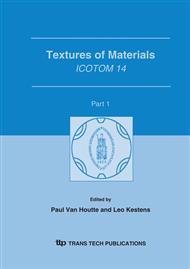p.1529
p.1535
p.1541
p.1547
p.1553
p.1559
p.1565
p.1573
p.1579
Effects of Texture and Anisotropy on Intergranular Stress Development in Zirconium
Abstract:
The influence of texture and anisotropy on the generation of intergranular stresses in clock-rolled zirconium is investigated using neutron diffraction and elastoplastic self-consistent modelling. Comparison between experimental data and model calculations indicates that the operation mainly of prismatic and basal slip explains the trends in intergranular stress evolution during in-plane tensile and through-thickness compressive deformation, whilst twinning plays a significant role during in-plane compression.
Info:
Periodical:
Pages:
1553-1558
Citation:
Online since:
September 2005
Authors:
Keywords:
Price:
Сopyright:
© 2005 Trans Tech Publications Ltd. All Rights Reserved
Share:
Citation:


